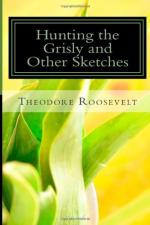A she-cougar does not often attempt to avenge the loss of her young, but sometimes she does. A remarkable instance of the kind happened to my friend, Professor John Bache McMaster, in 1875. He was camped near the head of Green River, Wyoming. One afternoon he found a couple of cougar kittens, and took them into camp; they were clumsy, playful, friendly little creatures. The next afternoon he remained in camp with the cook. Happening to look up suddenly he spied the mother cougar running noiselessly down on them, her eyes glaring and tail twitching. Snatching up his rifle, he killed her when she was barely twenty yards distant.
A ranchman, named Trescott, who was at one time my neighbor, told me that while he was living on a sheep-farm in the Argentine, he found pumas very common, and killed many. They were very destructive to sheep and colts, but were singularly cowardly when dealing with men. Not only did they never attack human beings, under any stress of hunger, but they made no effective resistance when brought to bay, merely scratching and cuffing like a big cat; so that if found in a cave, it was safe to creep in and shoot them with a revolver. Jaguars, on the contrary, were very dangerous antagonists.
CHAPTER VI.—A PECCARY HUNT ON THE NUECES.
In the United States the peccary is only found in the southernmost corner of Texas. In April 1892, I made a flying visit to the ranch country of this region, starting from the town of Uvalde with a Texan friend, Mr. John Moore. My trip being very hurried, I had but a couple of days to devote to hunting.
Our first halting-place was at a ranch on the Frio; a low, wooden building, of many rooms, with open galleries between them, and verandas round about. The country was in some respects like, in others strangely unlike, the northern plains with which I was so well acquainted. It was for the most part covered with a scattered growth of tough, stunted mesquite trees, not dense enough to be called a forest, and yet sufficiently close to cut off the view. It was very dry, even as compared with the northern plains. The bed of the Frio was filled with coarse gravel, and for the most part dry as a bone on the surface, the water seeping through underneath, and only appearing in occasional deep holes. These deep holes or ponds never fail, even after a year’s drought; they were filled with fish. One lay quite near the ranch house, under a bold rocky bluff; at its edge grew giant cypress trees. In the hollows and by the watercourses were occasional groves of pecans, live-oaks, and elms. Strange birds hopped among the bushes; the chaparral cock—a big, handsome ground-cuckoo of remarkable habits, much given to preying on small snakes and lizards—ran over the ground with extraordinary rapidity. Beautiful swallow-tailed king-birds with rosy plumage perched on the tops of the small trees, and soared and flitted in graceful curves above




